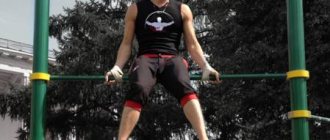Types of outdoor sports equipment
All horizontal bars are a type of sports equipment where the load is the exerciser’s own weight. Naturally, you can work with additional weighting, but the main idea of the horizontal bar is an extremely simple design without moving parts.
Conventionally, all modifications can be divided into several groups:
- the simplest U-shaped design. It is the most stable, easy to manufacture and at the same time makes it possible to perform a large number of exercises;
- wall horizontal bar (or ceiling). In terms of complexity they differ little from the U-shaped one; in fact, they are a modern “interpretation” of the very first horizontal bar - a tree branch. Attached to a permanent wall/ceiling or a special installation;
- double, triple models designed for different heights of users. Particularly convenient for families with children of different ages;
- combined designs, where in addition to the horizontal bar there is a wall bars, an emphasis for swinging the press and push-ups, parallel bars, rings, a ladder, a rope and other devices for body development.
When planning to make an outdoor horizontal bar with your own hands, you need to choose not only the modification, but also the material. Most often, wood or metal is used to create the structure.
Wooden products are as simple as possible to manufacture, do not require special tools, are quite strong (provided that the cross-section of lumber is chosen correctly), but, unfortunately, they are not very durable and can be damaged if the user is overweight or the load is applied incorrectly.
Metal complexes are stronger, more reliable and durable, but their production requires skills in working with metal - cutting, welding, painting.
Both types of structures are either mounted on an existing support or on pillar supports that are maximally firmly fixed in the ground/site.
What types of horizontal bars are there?
Basically, a horizontal bar is a sports equipment with one, two or more bars. They are often installed at different heights for the convenience of children and adults. Sometimes horizontal bars are supplemented with a ladder, rope, parallel bars, punching bags and other equipment for performing various exercises.
If we are talking about the home version of the horizontal bar, it is worth highlighting several of its main types.
Dimensions of the horizontal bar
Standard products are manufactured according to the dimensions of a certain “average user”. If the horizontal bar on the street is made with your own hands, it is logical to immediately design it to suit your physical characteristics.
One of the most important parameters is height. As can be seen from the diagram, the distance from the bar (bar) to the floor (ground) should be approximately equal to 1.28 x height. That is, for an adult with a height of 164 cm, the bar should be located at a height of approximately 210 cm, and for a child with a height of 140 cm - at approximately 180 cm. This distance takes into account height plus arm length. If your arms are noticeably shorter/longer than the standard, you can clarify the data for yourself this way: stand on tiptoes and stretch as high as possible. The height to which your fingertips reach is the approximate height of the horizontal bar. If the horizontal bar is made alone for the whole family, which has children, it is permissible to count on their growth. In this case, the adult performs pull-ups and other exercises with his legs tucked.
Important: regardless of the height of the bar, the distance to the obstacle located above (ceiling, canopy, tree branches, etc.) must be at least 32...35 cm. Otherwise, when pulling up sharply, there is a risk of hitting your head on the obstacle.
For “pull-ups with an exit” (photo above) and a number of other workout exercises, it is necessary to provide free space above the bar by about half the height (from the line passing through the center of the lowered fists to the top of the head).
Distance between supports . In standard products, this parameter is 1...1.5 m. Of course, if the horizontal bar will be attached to ready-made supports (for example, between two walls), this distance is known in advance. If not, it is better to determine it by its own physical parameters.
The minimum distance between the supports of the horizontal bar is the width of the shoulders (or hips, stomach - whichever is wider










